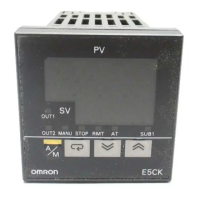CHAPTER 1 INTRODUCTION
E5CK
1–10
Ă• If you select [
], [ ], [ ] or [ ] in the menu display, the
level 0, program, level 1 and level 2 modes, respectively, are selected.
These modes are selected with control still continuing.
Ă• If you select[ĂĂ
] [ĂĂ ] [ĂĂ ] or [ĂĂ ] in the menu display, the
setup, expansion, option and calibration modes, respectively, are seĆ
lected.
When these modes are selected, the control is reset. So, control outputs
and auxiliary output are turned OFF. When another mode is selected
while in these modes control, reset is canceled.
Ă• To set the controller to the protect mode or to return to the level 0 mode
from the protect mode, press the
RUN/RST
key and the key simultaĆ
neously for 1 second minimum.
Ă• To set the controller to the manual mode, press the
key for one seĆ
cond minimum with the
key held down in the level 0 to 2 modes. To
return to the level 0 mode in the manual mode, press the
key for one
second minimum with the
key pressed. Be sure to press the key
first in this operation.
Ă• When the controller is not in the manual mode, each press of the
key
switches the parameter in the respective mode.
Parameter
1
Parameter
2
Parameter
3
Parameter
n
Ă• If you press the key when at the final parameter, the display returns
to the top parameter for the current mode.
Ă• When you change parameter settings or contents, specify the parameter
using the
or keys, and either leave the setting for at least two
seconds or press the
key. This fixes the setting.
Ă• When another mode is selected, the content of the parameters before the
mode was selected is fixed.
Ă• When you turn the power OFF, you must first fix the settings and paramĆ
eter contents (by pressing the
key or selecting another mode). The
settings and parameter contents are sometimes not changed by merely
pressing the
or keys.
JSelecting
parameters
JFixing settings

